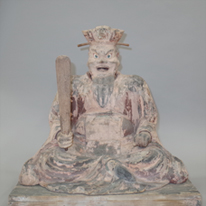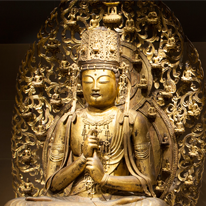Past Exhibitions
- Sculptures of Jizō (Ksitigarbha) and the Ten Kings of Hell
- December 15, 2015 - March 21, 2016
Unless a person was reborn in Buddhist paradise, it was believed that after death they would undergo judgment based on their lifetime actions. The deceased would appear before a panel of judges called the Ten Kings of Hell, under the leadership of King Enma (or Yama in Sanskrit). Sometime between the seventh day and third year after a person died, the Ten Kings would decide where to send them for their next life. The departed might be reincarnated into one of the Six Realms: the Buddhist hells or the realms of hungry ghosts, animals, troubled warriors, humans, or heavenly beings. To insure their best possible treatment in the afterlife, families of the deceased often conducted rituals to the Ten Kings at memorials ceremonies.
The bodhisattva Jizō (Avalokiteśvara), who has the shaved appearance of a monk, has the ability to guide people to salvation in the afterlife—even those who have descended into hell. Jizō was thus especially popular among those who believed in the Ten Kings and the Six Realms. The staff that he carries in his right hand is the symbol of a traveling cleric, telling us that this deity is making his rounds through the Six Realms of reincarnation.
- Japanese and Asian Sculpture
- December 15, 2015 - March 21, 2016













